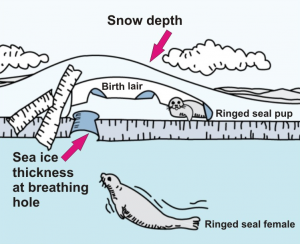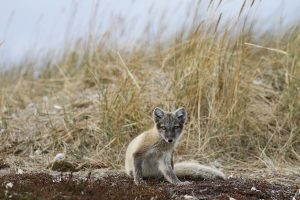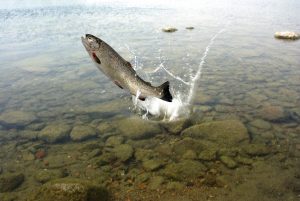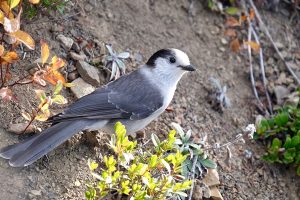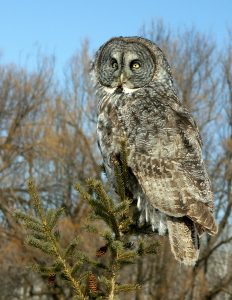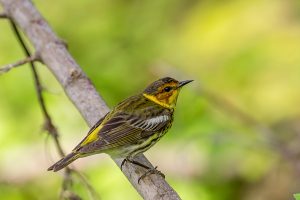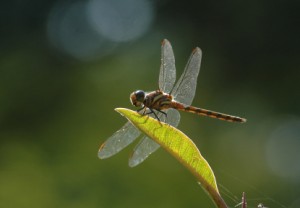 On this page, you will learn about climate change impacts
On this page, you will learn about climate change impacts
Click a link above to jump to that topic on this page.
From penguins in New Zealand to polar bears in Manitoba, wildlife all over the world are struggling to keep up with our rapidly changing climate. Over time, animals are often capable of adapting to new conditions. However, the process of recent climate change is too fast for many animals to adjust.
At the end of the Triassic, increased levels of atmospheric carbon dioxide and global warming are believed to have caused one of the largest mass-extinction events in Earth’s history (1).
World
Scientists around the world have noticed a wide variety of animals changing their habits in response to climate change. Some have been successful in adapting to climatic change. Others have not been as fortunate.
Fish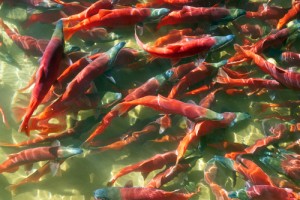
- Pacific salmon – Usually restricted by cold water temperatures, Pacific salmon species such as sockeye, pink, and Coho salmon have been found far outside their normal ranges (1). A Coho salmon was found almost 2,000 km further into northern waters than usual (2). Temperature increases in the Arctic as a result of climate change have allowed these temperate-water salmon to expand their ranges.
- Trout – Trout are a cold-water fish, thriving in spring- and glacier -fed water. Already struggling under the burden of pollution, erosion and diversion projects, trout are now – literally – in hot water. As climate change raises temperatures in North America, streams, rivers and lakes are becoming too warm for trout to survive (3). Brook, brown and rainbow trout will lose up to 76% of their habitat if greenhouse gases continue to build up and trap heat in the atmosphere (4).
Insects and other invertebrates
- Butterflies – In North America and Europe, over 35 species of butterflies have been expanding their ranges northward by up to 200 km (5). In the western U.S., Edith’s Checkerspot butterfly has not only shifted its range 92 km northward since the early 20th century, but has also gained 124 m in elevation (6).
- Coral reefs – Coral reefs provide food and shelter in one of the most biodiverse ecosystems on earth. Coral reefs have undergone global mass-bleaching events whenever sea temperatures have exceeded summer averages by more than 1°C for several weeks (7). Since 1979, mass-bleaching events are become more frequent and destructive.
In 1998, the most severe event thus far occurred, killing off 16% of the world’s coral reefs (8). New evidence suggests that that the increased levels of carbon dioxide in the atmosphere is acidifying the oceans and weakening the corals’ calcium carbonate skeletons. This makes them more vulnerable to storm damage and other erosion (9).
Coral reefs cover less than 1% of the ocean floor, yet provide food and shelter for over one-third of all marine fish (10).
Mammals
 Grizzlies – Nutritious whitebark pine seeds are a major food source for grizzly bears in western North America. The ability of a grizzly sow to successfully bare young is linked to pine seed abundance – more seeds mean healthier bear families (11). Unfortunately, whitebark pine is vulnerable to the impacts of climate change. Warm temperatures allows pine blister rust – a deadly, introduced fungus – to thrive and spread, killing up to 90% of whitebark pine in a given area (12). Less trees, less seeds, less bears.
Grizzlies – Nutritious whitebark pine seeds are a major food source for grizzly bears in western North America. The ability of a grizzly sow to successfully bare young is linked to pine seed abundance – more seeds mean healthier bear families (11). Unfortunately, whitebark pine is vulnerable to the impacts of climate change. Warm temperatures allows pine blister rust – a deadly, introduced fungus – to thrive and spread, killing up to 90% of whitebark pine in a given area (12). Less trees, less seeds, less bears.
Reptiles and amphibians
 In Costa Rica and North America, disastrous losses in frog, toad and salamander populations are climate related (13). With less winter precipitation, breeding pools aren’t deep enough to protect eggs and tadpoles from damaging ultraviolet rays. Weakened by UV-B radiation, they become susceptible to fungal infection, dying at epidemic rates. With inadequate water, over 50% of western toads succumb to fungal infection (14).
In Costa Rica and North America, disastrous losses in frog, toad and salamander populations are climate related (13). With less winter precipitation, breeding pools aren’t deep enough to protect eggs and tadpoles from damaging ultraviolet rays. Weakened by UV-B radiation, they become susceptible to fungal infection, dying at epidemic rates. With inadequate water, over 50% of western toads succumb to fungal infection (14).
In many reptiles, temperature determines the sex of offspring. Increased global temperatures could seriously skew sex ratios. A shortage of either sex could undermine a species’ ability to replace itself from generation to generation. In painted turtles, offspring sex ratio is correlated with mean July temperature (15). Even a modest temperature increase (2 – 4°C), could dramatically reduce the number of male turtles produced (16).
Birds
- Songbirds – Many songbirds are laying their eggs earlier in the United Kingdom. One-third of U.K. bird species are starting families 8.8 days sooner than usual (17). Birds of every feather are picking up the nesting pace: waterbirds, resident and migrant insect eaters, and seed-eaters are all responding to earlier spring-like temperatures and longer growing seasons.
- Sandpipers – Arctic regions will experience the strongest global warming as carbon dioxide levels rise. Over half of the tundra is expected to be replaced by boreal forest. Approximately 14 million Calidrid sandpipers (95% of the world’s population) raise young on the tundra (18). Scientists expect 7.5 million sandpipers to be lost as climate change eliminates their habitat (19).
- Penguins – In four years of unprecedented warm winters Adelie and Chinstrap penguin populations on King George Island have declined by 40 and 35% (20), respectively. Sea-ice cannot form on Antarctic seas warmed by climate change. The krill that typically feed on the algae are the primary food source of the penguins. As krill becomes scarce, penguins starve.
Arctic species
Many arctic animals rely on the predictable ebb and flow of sea ice for food and shelter:
- Arctic cod – Arctic cod are an important food source for seals and whales. Cod gather underneath sea ice, feeding on zooplankton. The abundant zooplankton subsist off algae that grows on the underside of the ice.
- Ringed seals – See Ringed seals in Manitoba Wildlife below
- Walruses – Walruses require a delicate balance of ice thin enough to break through with their heads, but thick enough to support their weight (21).
- Narwhals – Narwhals are almost always found close to sea ice. They prefer to forage for arctic cod at ice edges and cracks (22).
- See also Beluga whales in Manitoba Wildlife
- Beluga whales – See Beluga whales in Manitoba Wildlife below
- Bowhead whales – Bowhead whales feed on zooplankton, using sieve-like baleen in their mouths to filter massive mouthfuls of the tiny crustaceans (23). Without sea ice, the whales will have little to eat.
Manitoba
Polar bears
 In the last two decades, polar bears living in the western Hudson’s Bay area have undergone a change for the worse. Bears are returning from the sea ice underfed and underweight. In poor condition, mother bears are less likely to successfully become pregnant and raise offspring (1). To date, the number of offspring has declined and is expected to continue to decline, as the ice melts earlier and mothers cannot find enough food (2). The plight of Manitoba’s great white bears is inexorably linked to climate change.
In the last two decades, polar bears living in the western Hudson’s Bay area have undergone a change for the worse. Bears are returning from the sea ice underfed and underweight. In poor condition, mother bears are less likely to successfully become pregnant and raise offspring (1). To date, the number of offspring has declined and is expected to continue to decline, as the ice melts earlier and mothers cannot find enough food (2). The plight of Manitoba’s great white bears is inexorably linked to climate change.
The polar bear is the most carnivorous of the bears, feeding primarily on ringed seals and occasionally on bearded seals. Polar bears are at their leanest in March, just before the seal pupping season. Bears rely heavily on the predictable spring abundance of ringed seal pups to provide energy and nourishment for survival throughout the year – particularly for raising and nursing cubs (3).
Seal pups are abundant from their birth in April to the breakup of the sea ice in early summer. The pups are easier for polar bears to catch because they are inexperienced. Additionally, at six weeks of age, the body weight of ringed seal pups is about 50% fat (4). As a result, the bears are usually able to refill much of their dwindling energy stores every spring, stalking seals on the sea ice.
However, polar bears need stable sea ice as a solid surface on which to hunt ringed seals. Anything that affects the distribution and annual duration of sea ice has a profound effect on the health and well-being of polar bear populations (5). Since 1981, ice breakup on Hudson Bay has occurred earlier and earlier, forcing bears to come ashore in progressively poorer condition (6). Their hunting season cut short, they do not have enough time to regain their energy stores.
Increased temperatures caused by human-made greenhouse gas emissions are responsible for melting the arctic ice out from under the bears’ feet.
Ringed seals
 Ringed seals are an important food source for Polar Bears. They also depend on stable, landfast sea ice and adequate snow cover to rear pups (7).
Ringed seals are an important food source for Polar Bears. They also depend on stable, landfast sea ice and adequate snow cover to rear pups (7).
For seal pups to successfully grow, they require a birth lair (8). In ideal conditions, mother seals are able to dig holes in snow drifts that form over their breathing holes in the ice.
These lairs provide ringed seals with protection while the pups grow. However, with increasing arctic temperatures, the roof on birth lairs frequently collapse, leaving the mother and undernourished pups exposed to polar bears. While the bears may be gaining easier access to food sources, the ringed seal pups often have not yet gained their large fat deposits that polar bears rely upon.
Beluga whales
 Climate change is beginning to affect beluga whales through variations in their ecosystem and through increased human activity in the Arctic.
Climate change is beginning to affect beluga whales through variations in their ecosystem and through increased human activity in the Arctic.
Beluga whales are found in Hudson’s Bay, and almost always close to sea ice. They prefer to forage at ice edges and cracks (10). With unpredictable and sudden changes of weather due to climate change, beluga whales are more likely to become entrapped in the ice.
Beluga whales feed on varieties of cod, salmon, marine worms, shrimp, crab, and octopus (11). Changes in sea ice coverage affect the distribution and prevalence of these prey species, thereby limiting the whales’ ability to obtain enough food. These whales may also become more susceptible to predation and competition, as the water heats up and larger whales- such as killer whales, minke whales, and humpback whales- move into the belugas’ natural range.

Normal range of beluga whales (11).
However, the most serious consequences of climate change will likely come from the reduced sea ice, and the increase in human activity. With the decline in sea ice cover, humans have gained an increased interest in transportation routes through the pristine habitats of the beluga whales. Already, ship traffic in the Arctic has accelerated for shipping routes, gas extraction and exploration, and fishing. Not only are these vehicles physically invasive, their noise also impacts the whales.
Belugas are one of the most vocal marine mammal species, using clicks, whistles, and chirps to communicate with each other and to locate other objects. With increased human activity, especially in areas such as Hudson Bay where large populations of beluga whales live, the seismic changes may inhibit their ability to communicate and successfully find food.
Additionally, the increase in human activity in the Arctic will lead to additional pollution. The concentrations of some contaminants grow exponentially through the food chain. As beluga whales are near the top of their food chain, they are particularly susceptible to obtaining high levels of toxins in their blubber and organs.
Woodland caribou
Woodland caribou range from northern Yukon, across the country to Newfoundland. Manitoba is home to a strong, yet declining population that lives within the boreal forest.
As the temperature warms, the changes in soil nutrients reduce the availability of forage plants in caribou’s natural range (12). Taiga and shrubland plant species are moving northward, drawing southern ungulates, such as moose, that outcompete caribou. Unfortunately, existing populations in northern regions limit the range in which Manitoba’s caribou population can migrate away from their competitors.
With increased changes in climate, the boreal forest is expected to face increasing severity and occurrence of forest fires, which will further damage the caribou population.
Lynx
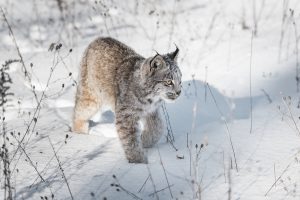 Canadian lynx are found within Manitoba’s boreal forest. Changes in the climate are disrupting lynx through its important relationship with its prey, snowshoe hares. With rising temperatures in Manitoba, come an increase in rainfall and a decrease in snow, which are impacting the availability of plants for hares (13). Reducing hare survival rates greatly impacts the ability for lynx to find sufficient food.
Canadian lynx are found within Manitoba’s boreal forest. Changes in the climate are disrupting lynx through its important relationship with its prey, snowshoe hares. With rising temperatures in Manitoba, come an increase in rainfall and a decrease in snow, which are impacting the availability of plants for hares (13). Reducing hare survival rates greatly impacts the ability for lynx to find sufficient food.
Additionally, as lynx are forced to retract their territories due to a changing climate, they also face increased competition with coyotes, bobcats, and avian predators.
Fox
In Canada, general warming is allowing red foxes to expand their range northward (14). Unfortunately for arctic foxes, red foxes are better suited to living in a warmer environment. Red foxes are also more aggressive and have been known to kill their arctic counterparts. Both foxes are slightly larger than a domestic cat, with the red fox standing a few centimeters taller. In terms of adaptations, arctic foxes have thick fur and increased blood circulation that keep them well-adapted to extreme temperatures. With rising temperatures, red foxes are able to compete despite not having these specific adaptations. As a result, arctic foxes are retreating further north as their habitat shrinks.
Monarch butterflies
 Monarchs depend on various environmental cues to determine when to migrate, reproduce, and hibernate (15). Therefore, major changes in weather and climate greatly affect monarch butterflies’ ability to survive. In particular, extreme highs and lows in temperature are killing populations of butterflies. Additionally, milkweed- an important plant for monarchs- is declining in the normal range due to the increased use of herbicides on corn and soybean crops (16). Monarchs lay their eggs on milkweed and exclusively feed on this plant variety. With declines in the plant, monarch butterfly populations are nearing threatened.
Monarchs depend on various environmental cues to determine when to migrate, reproduce, and hibernate (15). Therefore, major changes in weather and climate greatly affect monarch butterflies’ ability to survive. In particular, extreme highs and lows in temperature are killing populations of butterflies. Additionally, milkweed- an important plant for monarchs- is declining in the normal range due to the increased use of herbicides on corn and soybean crops (16). Monarchs lay their eggs on milkweed and exclusively feed on this plant variety. With declines in the plant, monarch butterfly populations are nearing threatened.
Fish
Coldwater fish species, such as lake trout and slimy sculpin, are beginning to feel the effects of climate change. As lake water temperatures rise, coldwater species are moving to deeper, cooler parts. However, deeper areas have less oxygen and lower quality food, which limits the growth of lake trout (17). With less energy, fish are unable to produce eggs or spawn, resulting in lower reproductive rates and population sizes. Additionally, as top predators, the impact on lake trout has a cascading effect on the overall food web.
Warm-water fish species, such as smallmouth bass, may benefit from increased water temperatures by gaining additional habitat (18). As a result, these fish species may expand their northern limits, which unfortunately could negatively impact native fish species (19). One of these affected fish species includes lake trout. With lake trout already facing a decrease in their diet- due to their move to colder water- the influx of competitive smallmouth bass could further impact lake trout. In Ontario alone, it is estimated that the number of lakes with vulnerable lake trout populations will move from 1% to 20% by 2050 (20).
Birds
Grey Jays & Boreal Chickadees
Greatest climate changes in Northeastern North America will occur during winter. Therefore, bird species that are active in the winters will be impacted most harshly (21). Grey jays and boreal chickadees fall into this category, and researchers have already begun to see a decline in their populations. Warming climates change these species’ fecundity and survival rates overall.
In particular, boreal chickadees are most impacted by a loss of habitat, due to the northward shift of the boreal forest. These bird species, while adaptable, may not be able to move fast enough with the changing habitat.
The greatest challenge for gray jays relates to their diet. Grey jays hoard food supplies over the boreal winter. With warmer winter weather, their perishable food stocks are not staying cool enough to last. As a result, adults are not gaining enough nutrients, which reduces the number of breeding pairs and the population overall. The southern ranges of their habitat is also shrinking as warmer conditions lower habitat quality.
Changes to the boreal forest may also lead to both boreal chickadees and grey jays becoming impacted by other bird species that move into their natural range.
Boreal Owl Species
Climate directly impacts the breeding performance of vole-eating predators, such as great grey owls, hawk owls, and boreal owls. Larger bird species, such as these, rely on a specific temperature gradient for breeding tactics to occur. Therefore, boreal owl species are more sensitive to changes in weather, and climate overall. With increased climate change, a reduction in breeding could lead to a serious decline in these species’ populations (22)
Cape May Warblers
Cape may warblers are specialist species that rely heavily on spruce budworms as a diet source. It is believed that these two species adapted together. However, with climate change, it is unknown whether they will continue to adapt simultaneously. The cape may warblers’ migration to Manitoba is triggered by the increased daylight hours of spring. Spruce budworms, on the other hand, begin to hatch in the spring when the temperatures rise. Presently, the arrival of the birds is timed so that they are greeted by an abundance of budworms. However, with the increase in spring temperatures, the spruce budworm emergence may occur earlier than the arrival of their predators. As a result, when the cape may warblers arrive and hatch their young, their main food source may be well on its way to becoming undesirable adults. Cape may warbler populations may therefore decline (23). Without the bird species around as predators, fir and spruce trees could fall to outbreaks of budworms.
Climate change will also impact the availability of prey species, as well as changes in the prevalence of diseases. Citizen science studies- such as bird surveys and counts- will play a pivotal role in monitoring changes among all boreal bird species.



